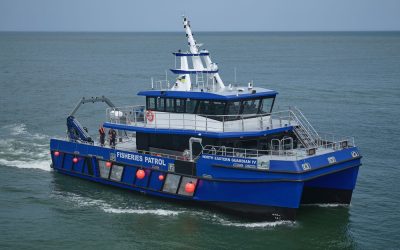Standardised hullforms mean many workboats came to look a lot like each other. However, times are changing, mostly driven by the need to reduce the marine sector’s carbon footprint, alongside a growing understanding that alternative fuels will only provide, at best, a partial answer, writes Stevie Knight.
Therefore, Seawork 2024, hosted in June, saw a variety of different hullforms on display, many taking advantage of foiling systems.
The new designs don’t have to be big or complex to deliver ecological and fuel savings. Take Swiftcat’s Thunderstruck: a simplified, 9.6m foiling catamaran that yields 25% efficiency by getting its hull most of the way (though not completely) out of the water. Below its 3.6m beam is a central, fixed main foil, plus two smaller trim foils at the rear.
The concept’s high tunnel means head seas can be taken at speed, and the deck remains dry while loitering in following seas. Inside the tunnel, long chines break up the water before it hits the roof, helping to retain a comfortable ride in rough conditions. Additonally, a shock-breaker can be fitted for more challenging waters. Thunderstruck’s passive foiling system carries about 75% of the vessel’s displacement when travelling at 16-18knots. Besides decreasing drag, it also improves seakeeping, which gives the boat a greater payload capacity, as well as a better turning response and lower wake. Importantly, the foils sit between the hulls and shelter inside the vessel’s outline so the boat can dry out without damage.
Thunderstruck has recently had an extensive fit-out for the Inshore Fisheries & Conservation Authority, making it a fairly hefty unit. However, the top speed is still around 23knots and, even with the foils down in the water in displacement mode, Thunderstruck has a draught of just 0.8m, making it ideal for traversing its home grounds around the Norfolk Wash.
Still, this Swiftcat 150 model was not the only design on display: there was also an 11.4m model which has recently started to benefit from vacuum infusion techniques, saving about 1.5tonnes in resin, meaning this version can achieve a speed of 46knots with 300hp (224kW) outboards.

Optima’s 10.5m electric trimaran prototype: the 14m production model will be a contender for the water taxi market
Also on the Seawork pontoon was Optima Projects’ 10.5m electric ‘test bed’ trimaran, with its slender bow, integral sponsons and 150-mile range – not bad on a 126kWh battery. But this is just a step toward the 14m-long, 4.5m-beam production version with double the energy storage and a 100kW drive, aimed at the commercial water taxi market.
While the shape is futuristic, it’s far from speedy – rather the opposite, underlines David Kendall, Optima CEO. In fact, the point of the refined, lightweight build (the new design will only be 9-10tonnes, including batteries) is to make life cleaner, greener and far more comfortable. “Dialling the speed back to 15-18knots is far more pleasant for passengers,” says Kendall, adding that it will result in a very different ride from the slamming typical of planing vessels. It should also result in a level trim and little bow acceleration, meaning the boat’s structure takes less of a pounding.
Optima has been collaborating with Seabird Technologies, so foils are soon to be integrated into the design. Again, these will be completely passive, but taking around 30% or 40% of the displacement onto the foils should permit a speed of around 18-20knots while enabling a commercially viable range of about 50 miles.

Strategic Marine and ESNA are extending their collaboration to bring SES CTVs to the wider market
The Seawork halls also hosted other hull alternatives – some of which are gaining significant traction. For example, long-standing exhibitors Aircat/ESNA demonstrated how surface effect ship (SES) principles are making headway on CTV designs.
As these reduce displacement by trapping a cushion of air between the twin hulls, the result is a substantial fuel and carbon saving, even at higher speeds. For example, the hybrid CWind Pioneer (launched in 2021) can get up to 43.5knots and still be 20% more efficient, mile-for-mile, than CTVs running at 24knots, the service company says. Importantly, the SES ‘cushion’ has integral motion damping, providing better seakeeping and greater passenger comfort, as well as allowing transfers in higher waves. Most recently, Strategic Marine (also in force at the show) and ESNA have decided to extend their collaboration to bring SES CTVs to the wider market: the first build will commence later this year.






